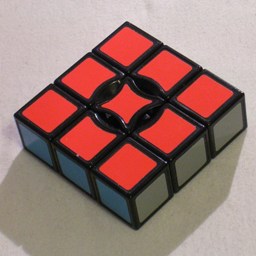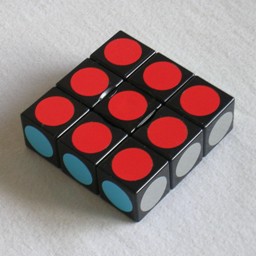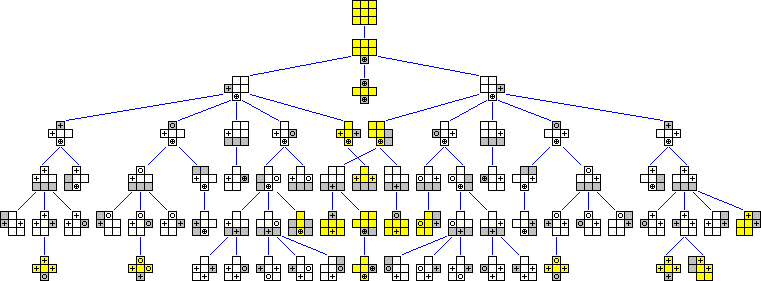



This puzzle is generally known as the Super Floppy, as it is a Floppy Cube which also allows quarter turns. This allows the corner pieces to move to locations above and below the edge pieces, changing the shape of the puzzle. It was also invented by Katsuhiko Okamoto.
There are two versions of the puzzle. The official version has an internal mechanism that blocks you from twisting a side consisting of only an edge piece without any corners. The imitation version lacks that mechanism, and by allowing you to twist an edge piece in isolation makes this easy puzzle much easier.
There are 4 corners which can be in any of 12 locations. The edge pieces don't travel, but do have 4 orientations each. This gives a total of 12·11·10·9·44 = 3,041,280 positions. All of these are attainable.
Suppose we consider only the shape of the puzzle, ignore the colours. Then there are 12-choose-4 = 12!/(8!4!) = 495 ways the corners can be arranged if the puzzle has a fixed orientation. The puzzle as a whole has 8 orientations, so there are about 495/8 possible shapes. Some shapes have symmetry, so to calculate the exact number we need to apply Burnside's Lemma. This gives 72 distinct shapes. Only 18 shapes are mirror symmetric and the rest form 27 mirror image shape pairs.
I have used a computer search to find God's Algorithm, i.e. the shortest solution for each position. Every position of the official super floppy can be solved in at most 15 moves (9.8558 on average) or if a half turn is considered to be two moves it takes at most 17 moves (12.115 on average). The result for both metrics is shown in the following table:
| Face turn metric | |||||||||||||||||||
|---|---|---|---|---|---|---|---|---|---|---|---|---|---|---|---|---|---|---|---|
| Q u a r t e r t u r n m e t r i c |
0 | 1 | 2 | 3 | 4 | 5 | 6 | 7 | 8 | 9 | 10 | 11 | 12 | 13 | 14 | 15 | Total | ||
| 0 | 1 | 1 | |||||||||||||||||
| 1 | 8 | 8 | |||||||||||||||||
| 2 | 4 | 40 | 44 | ||||||||||||||||
| 3 | 40 | 128 | 168 | ||||||||||||||||
| 4 | 10 | 240 | 224 | 474 | |||||||||||||||
| 5 | 144 | 736 | 704 | 1,584 | |||||||||||||||
| 6 | 24 | 904 | 2,016 | 2,144 | 5,088 | ||||||||||||||
| 7 | 424 | 3,136 | 6,880 | 4,568 | 15,008 | ||||||||||||||
| 8 | 53 | 2,712 | 11,440 | 17,744 | 10,560 | 42,509 | |||||||||||||
| 9 | 984 | 10,848 | 36,568 | 42,424 | 20,960 | 111,784 | |||||||||||||
| 10 | 64 | 6,160 | 39,460 | 94,382 | 88,920 | 32,896 | 261,882 | ||||||||||||
| 11 | 1,352 | 23,840 | 112,112 | 199,504 | 142,976 | 36,864 | 516,648 | ||||||||||||
| 12 | 31 | 6,228 | 66,146 | 222,228 | 289,752 | 158,296 | 25,168 | 767,849 | |||||||||||
| 13 | 744 | 17,736 | 112,880 | 254,816 | 255,056 | 102,624 | 13,184 | 757,040 | |||||||||||
| 14 | 4 | 1,120 | 20,056 | 88,432 | 160,112 | 126,672 | 35,040 | 1,792 | 433,228 | ||||||||||
| 15 | 24 | 992 | 7,440 | 26,848 | 51,248 | 29,408 | 2,432 | 118,392 | |||||||||||
| 16 | 1 | 20 | 160 | 672 | 2,408 | 3,936 | 1,792 | 576 | 9,565 | ||||||||||
| 17 | 8 | 8 | |||||||||||||||||
| Total | 1 | 12 | 90 | 536 | 2,341 | 9,616 | 38,855 | 129,156 | 344,505 | 665,560 | 816,480 | 637,848 | 308,120 | 81,568 | 6,016 | 576 | 3,041,280 | ||
The eight QTM antipodes are positions with solved corners, three edges that need a half turn, and one that needs a quarter turn.
For the imitation super floppy need at most 13 moves to solve (9.0040 on average), or 16 (11.266 on average) if a half turn is considered to be two moves. The results are as follows:
| Face turn metric | ||||||||||||||||
|---|---|---|---|---|---|---|---|---|---|---|---|---|---|---|---|---|
| Q u a r t e r t u r n m e t r i c |
0 | 1 | 2 | 3 | 4 | 5 | 6 | 7 | 8 | 9 | 10 | 11 | 12 | 13 | Total | |
| 0 | 1 | 1 | ||||||||||||||
| 1 | 8 | 8 | ||||||||||||||
| 2 | 4 | 40 | 44 | |||||||||||||
| 3 | 40 | 160 | 200 | |||||||||||||
| 4 | 10 | 256 | 512 | 778 | ||||||||||||
| 5 | 144 | 1,152 | 1,376 | 2,672 | ||||||||||||
| 6 | 24 | 1,120 | 3,920 | 4,064 | 9,128 | |||||||||||
| 7 | 464 | 5,488 | 13,408 | 10,288 | 29,648 | |||||||||||
| 8 | 53 | 3,596 | 21,394 | 40,096 | 20,128 | 85,267 | ||||||||||
| 9 | 1,096 | 17,280 | 72,848 | 96,120 | 31,168 | 218,512 | ||||||||||
| 10 | 60 | 7,416 | 64,948 | 195,408 | 171,600 | 32,720 | 472,152 | |||||||||
| 11 | 1,344 | 31,416 | 185,480 | 357,784 | 185,120 | 17,792 | 778,936 | |||||||||
| 12 | 29 | 6,336 | 86,232 | 325,300 | 345,328 | 80,224 | 1,792 | 845,241 | ||||||||
| 13 | 528 | 18,272 | 126,056 | 241,456 | 95,360 | 3,360 | 485,032 | |||||||||
| 14 | 4 | 980 | 15,640 | 54,652 | 34,464 | 2,192 | 32 | 107,964 | ||||||||
| 15 | 8 | 408 | 2,592 | 2,368 | 256 | 5,632 | ||||||||||
| 16 | 1 | 48 | 16 | 65 | ||||||||||||
| Total | 1 | 12 | 90 | 584 | 3,301 | 15,536 | 64,935 | 226,464 | 602,629 | 1,027,956 | 861,916 | 230,224 | 7,600 | 32 | 3,041,280 | |
If you ignore the colours and consider only the shape of the puzzle, then it takes at most 6 moves to solve. The results are as follows:
| Face turn metric | ||||||||||
|---|---|---|---|---|---|---|---|---|---|---|
| Q T M |
0 | 1 | 2 | 3 | 4 | 5 | 6 | Total | ||
| 0 | 1 | 1 | ||||||||
| 1 | 4 | 4 | ||||||||
| 2 | 18 | 18 | ||||||||
| 3 | 8 | 64 | 72 | |||||||
| 4 | 64 | 64 | 128 | |||||||
| 5 | 12 | 64 | 96 | 172 | ||||||
| 6 | 4 | 80 | 16 | 100 | ||||||
| Total | 1 | 4 | 26 | 140 | 132 | 176 | 16 | 495 | ||
Phase 1: Solve the shape, i.e. make it flat.
The tree diagram below shows all possible shapes, and you can use it to solve the shapes optimally. The shapes coloured yellow are symmetric, the others occur in mirror image pairs, one on each side.

Phase 2: Solve the pieces.